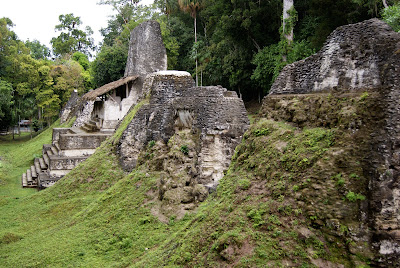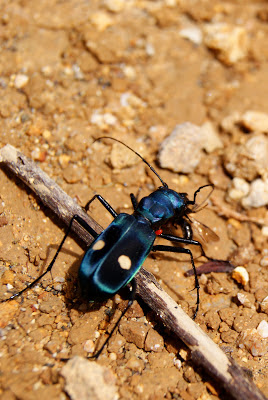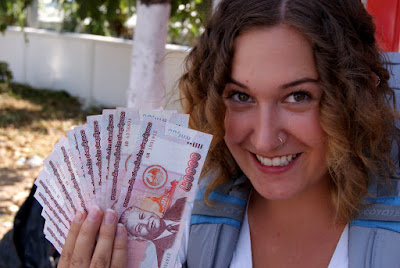Christmas 2010, Win and I were given an incredible,
unexpected gift: a week off from teaching, contingent on our doing a “visa run”
to Laos. Your typical visa run involves going to a Thai consulate in another
country with a massive envelope of paperwork (Laos, apparently on best consular
terms with Thailand, is the country of choice among teachers), waiting x number
of days, and going back to Thailand with a Non-Immigrant B visa in-hand. However,
having decided to get yearlong multiple entry visas, our visa run was a cake
walk: leave Thailand, see another country, come back to Thailand and get a new
3-month entry stamp. So to Laos we went.
Twelve hours on a train, an hour waiting around at the
border crossing, and a single sign telling drivers to start driving on the
right, and we were in Laos. Flat, dry, and rundown, Laos’ capital city of
Vientiane made for a lackluster first impression. Buildings, storefronts, even
the stray cats, everything was sparse, dismal.

Aside from the presence of a bowling alley and the city
signage having French flair – a trait that carried over to street, restaurant,
and hotel names – Vientiane was very much like a small Thai city. The manner
and language were similar; the architecture and tuk-tuk drivers much the same;
there were the same orange-robed monks, the same women hiding from the sun
beneath umbrellas, the same stray dogs rummaging through garbage. We navigated the
city on foot, walked its streets, saw its museums. We ate its food, drank its
beer, and spent its devalued kip (worth so little, I was withdrawing a million
kip from ATMs the whole time, which was bizarrely satisfying in its own right).
After a day and a half, in what would turn out to be a moment of poorly
executed planning, we boarded a bus to head into the heart of northern Laos.
Having been told that there wasn’t a bus leaving for Luang
Prabang until evening, we were surprised when the ticket seller told us a bus
would be leaving at 4 pm. As we stowed our backpacks and climbed aboard, it
seemed a positive turn of events, catching a bus right as we arrived at the
station. As the passengers were finding seats, the driver and some helpful
hands started filling the aisle with packages, copious amounts of luggage, bags
of rice, and all manner of freight, including three pieces of PVC piping, a
foot in diameter and at least 12-feet long. In order to reach our seats, we now
had to clamber and balance our way over piping, walking along armrests at
times.

And so we set out, luggage shifting precariously in the
aisle, Lao karaoke blaring and crackling from the speakers. Up and around
steep, jutting hills, through luscious jungle foliage, encroaching thick and
dark along the roadside, pushing its way toward the bus windows. As mid-afternoon
gave way to evening, we passed through meager villages, clusters of single-room
homes, many without furniture or front doors. The countryside wore its poverty
openly. Bonfires served as stoves, simple elevated bamboo platforms as beds, possessions
were few. Late into the night, long after the small village clusters went to
sleep, the bus lumbered jerkily along half-finished roads, karaoke still
blaring.

After twelve cramped hours, we arrived in Luang Prabang at 4
am. The whole town, all guesthouses and hotels, was sound asleep. We tried
knocking on doors, calling phones, checking to see if anything was unlocked,
all to no avail. So, we sat down somewhere well-lit to read and nap and waited
for Luang Prabang to rub the sleep from its eyes.
Ill-timed though it may have been, our 4 am arrival had two
unexpected benefits. First, as the sun started to peek over the mountains and
the town stirred to life, we got to start our day off with fresh fruit-filled crepes,
a treat one would be hard-pressed to find in Thailand. Also, we got to witness Luang
Prabang’s famed procession of monks, numbering into the hundreds, lining the
streets every morning bowl-in-hand, going from storefront to doorway, collecting
alms, something many tourists wake early to see.
After schlepping around and scoffing at prices (“Only 40 US
dollars a night”), we finally found a place to bed down for several days. It
was a dank little hole of a room next to the guesthouse kitchen, but it was
affordable. Luckily, as we discovered after napping well into the day, Luang
Prabang was a lovely town, giving us little reason to spend excess time in our
room.
Nestled between the Mekong and Nam Khan Rivers, The Unesco
World Heritage city of Luang Prabang sits high above the flowing waters on its
hilltop peninsula. It was my first tryst with a World Heritage City, a first
fling that would, unbeknownst to me at the time, turn into a travel love
affair.
Roaming around town, the architecture is awash in French
colonial remnants; beautiful balconies, wooden shuttered windows, massive homes
mixed in with smaller, more Southeast Asian structures. Cafes, baguettes,
creperies, Luang Prabang embraced its heritage as part of the French colony
Indochine, using it as a tourist selling point surely, but also full of genuine
relics of its past.
French remains Laos’ dominant second language (though it is
being steadily overtaken by English), and to hear the Laos (plural of Lao, referring
to the people of Laos) speak French was a surreal experience. There was none of
the harsh, nasally, pretentious quality that you get when listening to French
or other Europeans speak; instead, the words were tranquil, a calm, steady flow,
all rounded edges and curved letters. It was delightful to listen to, as if the
Laos spoke French as it was intended, a beautiful, delicate language.

Mixed in with its French heritage, an abundance of Buddhist
temples stood their ground, solidly announcing Luang Prabang’s Buddhism.
Although, with the highest number of Buddhist monks per capita (a statistic I
might be making up, but there were certainly an impressive number of monks),
the predominance of Buddhism in the area announces itself. Everywhere we
walked, groupings of orange-robed monks, from small male children to wrinkled
elderly men, meandered along the streets. In all of Thailand, never had I seen
so many monks, especially child monks, all in one place.
Despite the attempts around town to appear more festive,
garland and lights and trees appearing in large numbers, it wasn’t a
particularly Christmasy Christmas. And, with near-tropical temperatures, it
certainly wasn’t a white Christmas (although I don’t know that Southeast Asians
would know what to do with themselves if it ever did snow).
In fact, we spent Christmas Day flying back to Bangkok
through Luang Prabang’s ‘International Airport’ (a building so small it resembled
a bus station more than an airport). The flight was my Christmas present to us,
a way of avoiding 24 hours on buses and trains. Buying airline tickets also
gave us time enough to spend three days soaking in Luang Prabang: enjoying its
dichotomous culture, eating French, Lao, and French-Lao food (I even ate some
buffalo), and most of all, just relaxing, reading, and relaxing some more.



























































